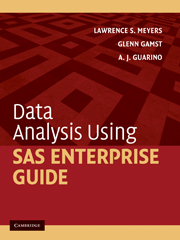Book contents
- Frontmatter
- Contents
- Preface
- Acknowledgments
- I Introducing SAS Enterprise Guide
- II Performing Analyses and Viewing Output
- III Manipulating Data
- IV Describing Data
- V Score Distribution Assumptions
- 12 Detecting Outliers
- 13 Assessing Normality
- 14 Nonlinearly Transforming Variables in Order to Meet Underlying Assumptions
- VI Correlation and Prediction
- VII Comparing Means: The t Test
- VIII Comparing Means: ANOVA
- IX Nonparametric Procedures
- X Advanced ANOVA Techniques
- XI Analysis of Structure
- References
- Author Index
- Subject Index
13 - Assessing Normality
Published online by Cambridge University Press: 05 June 2012
- Frontmatter
- Contents
- Preface
- Acknowledgments
- I Introducing SAS Enterprise Guide
- II Performing Analyses and Viewing Output
- III Manipulating Data
- IV Describing Data
- V Score Distribution Assumptions
- 12 Detecting Outliers
- 13 Assessing Normality
- 14 Nonlinearly Transforming Variables in Order to Meet Underlying Assumptions
- VI Correlation and Prediction
- VII Comparing Means: The t Test
- VIII Comparing Means: ANOVA
- IX Nonparametric Procedures
- X Advanced ANOVA Techniques
- XI Analysis of Structure
- References
- Author Index
- Subject Index
Summary
Overview
Many statistical procedures (e.g., analysis of variance) have as one underlying assumption that the variables to be analyzed are distributed in a manner best described by the normal curve (see Gamst et al., 2008). Most statistical analysis software packages are able to compute several different tests of normality, and it is common for researchers to perform such tests in the first stages of their data analysis.
The normality tests provided by SAS
When users select normality tests, SAS Enterprise Guide automatically computes and displays the results for four such tests: Shapiro–Wilk, Kolmogorov–Smirnov, Cramer–von Mises, and Anderson–Darling. We very briefly characterize each of these in the subsequent text.
Shapiro–Wilk
The Shapiro–Wilk test for normality is perhaps the most widely used test of the four computed by SAS. It is based on regression techniques. In its early version it was appropriate for sample sizes up to 50 (Shapiro & Wilk, 1965), but SAS has incorporated a modification proposed by Royston (1992) to extend the procedure to sample sizes up to about 2,000. Based on a review of the tests that are available, D'Agostino (D'Agostino, Belanger, & D'Agostino, 1990; D'Agostino & Stephens, 1986) concluded that, among several alternative normality tests (not available through SAS), the Shapiro–Wilk test was excellent.
Kolmogorov–Smirnov
The Kolmogorov–Smirnov test quantifies the differences between the observed and expected distribution by estimating the relative height of the distribution at many places. It works best with more than 2,000 cases.
- Type
- Chapter
- Information
- Data Analysis Using SAS Enterprise Guide , pp. 130 - 134Publisher: Cambridge University PressPrint publication year: 2009



